Exchange-traded funds are getting a revamp at Goldman Sachs.
The big bank has doubled down on a concept called smart beta, which blends passive and active investing strategies to build portfolios based on non-traditional metrics. At Goldman, the strategy is branded as ActiveBeta and revolves around four factors: value, quality, momentum and low volatility.
“We actually had these strategies existing inside Goldman for a number of years,” Steve Sachs, head of capital markets for ETFs at Goldman, told CNBC’s “ETF Edge.” “The ActiveBeta strategies have a significant amount of institutional assets benchmarked to them in separate account form. Our institutional clients and our advisor clients were coming to us and asking us, ‘Can you deliver these strategies in an ETF?'”
Goldman created what is now an 18-product suite of ETF offerings with $12 billion in assets under management. But the crown jewel is the ActiveBeta suite and its flagship, the ActiveBeta U.S. Large Cap Equity ETF, which trades under the ticker GSLC, Sachs said.
The large-cap ETF counts the stocks of technology giants Microsoft, Apple, Amazon and Facebook among its holdings and has attracted nearly $5 billion in assets from investors, according to Sachs.
“When you look at GSLC since inception and, certainly, if you look at the last year, GSLC actually outperformed 80% of all of the mutual funds and ETFs out there in the large-blend category,” the ETF chief said. “The idea is this: At the end of the day, the hardest part of the puzzle is the asset allocation,” he continued. “Securities selection becomes a very challenging exercise, particularly in U.S. large cap.”
But when you consider what most active money managers look for, those four key characteristics — value, quality, momentum and low volatility — come up again and again, Sachs said, adding that all of Goldman’s ActiveBeta ETF products use the same strategy.
“We think single-factor investing is very, very difficult,” he said. “Very hard to time factors. Very hard to pick which one is going to be in favor this year. When you combine four factors like the ones that we do, they actually have a very low — or even, in most cases, very negatively correlated — relationship to each other.”
Goldman leverages that correlation to reduce risk and, hopefully, give investors a better risk-adjusted return, Sachs explained.
“It’s also all about tracking error, and what do I mean by that? It’s the amount of risk you’re taking versus the S&P 500 or the [market] cap-weighted benchmark,” he said. “The idea with multi-factor investing should really be to take a small amount of tracking error to give yourself a much better risk-adjusted return, not making outsized bets, particularly in things like low-[volatility], which can actually go against you, strangely.”
Not everyone’s convinced by Goldman’s new strategy. Dan Wiener, chairman of Adviser Investments, drew a comparison with Vanguard, which introduced its own factor-based investing products a year ago.
“If you look at the performance month to month, quarter to quarter, it’s all over the map,” he said on “ETF Edge.” “Of the five or six different factor ETFs that Vanguard’s come up with, the two with the most money have been the two worst performers since inception […] I hate to be the cynic on the show here, but factors is just another fancy way of saying, ‘We’re going to slice the baloney a little differently.'”
Tom Lydon, editor and proprietor of ETFTrends.com and president of Global Trends Investments, saw more opportunity — even as he acknowledged the inherent risks of investing just based on these factors.
“There is factor-chasing that goes on,” he said in the same interview. “People buy the wrong factors at the wrong times. However, if you look back when early factor investing in the ETF space was really getting hot, it was pre-financial crisis. And through ’07 to ’09, those factor strategies did quite well compared to [market cap] weighted. So we really are in a situation where those that are looking at factors are doing it because they want a defensive strategy [and] they feel the market might be a little bit long in the tooth.”
Goldman Sachs’ ActiveBeta U.S. Large Cap Equity ETF closed at XXXX on Thursday and is up XXX year to date.

